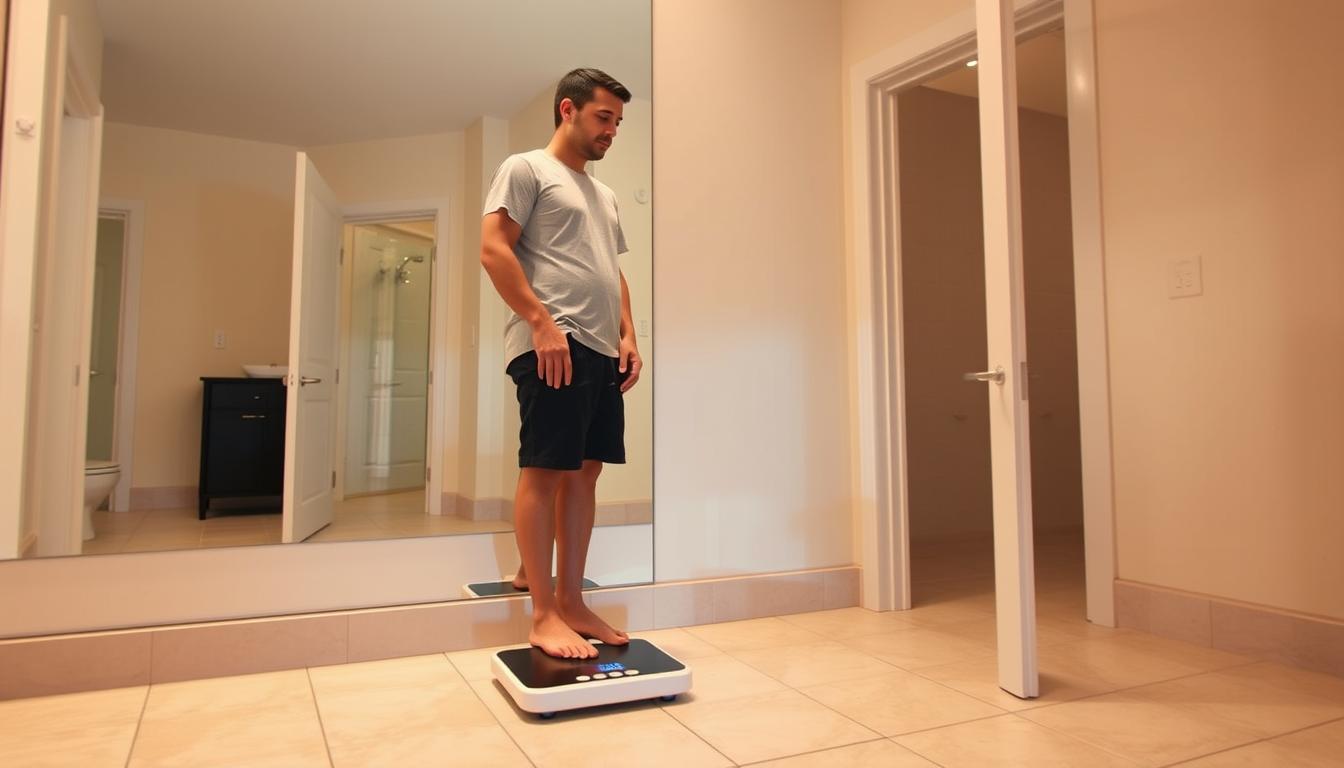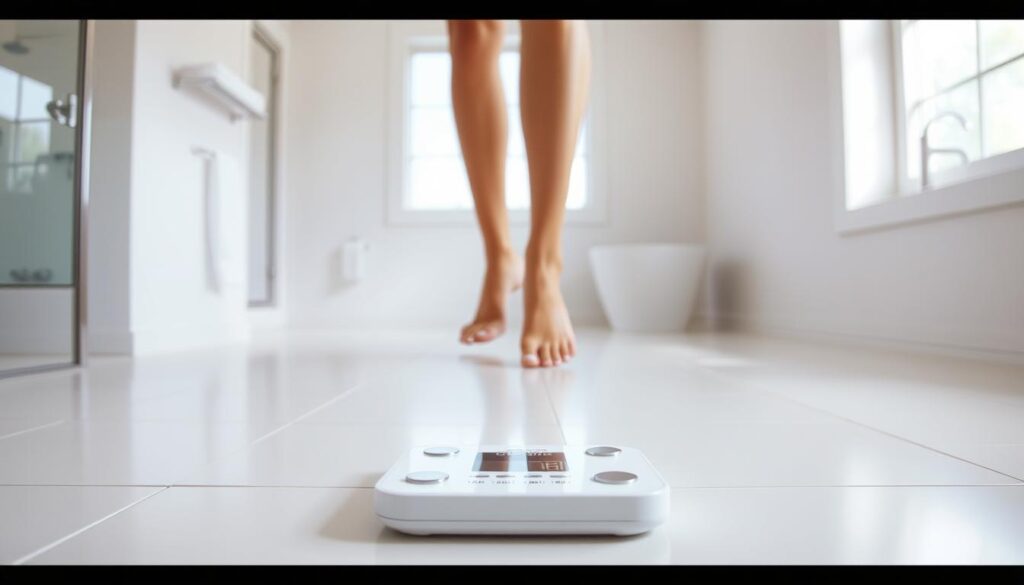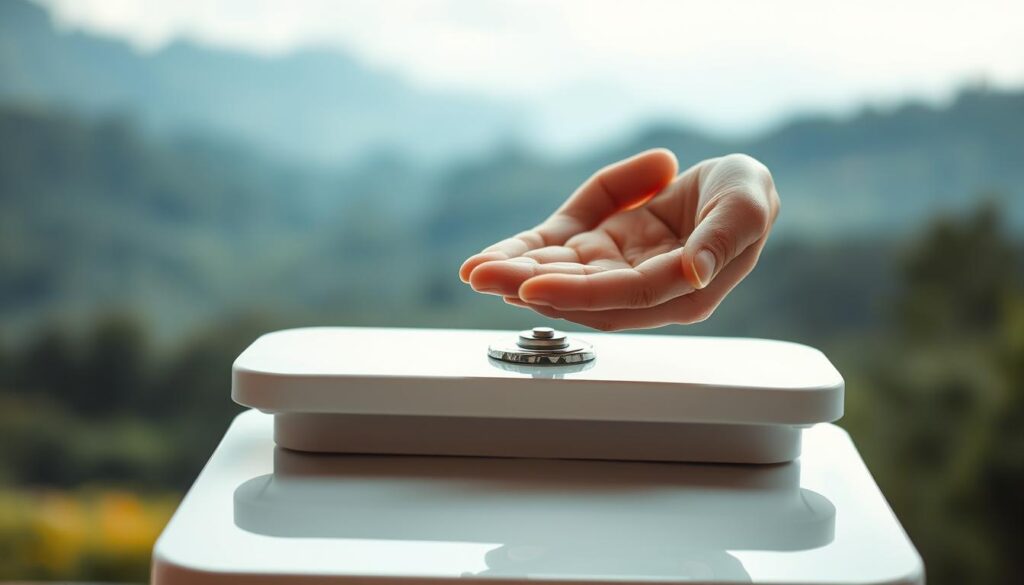Could your daily weigh-in routine be sabotaging your ability to track real progress? While many assume any moment works for monitoring body changes, research reveals surprising truths about how timing impacts your numbers.
We’ve analyzed data from nutrition experts like Maxine Smith to uncover why mornings provide the clearest snapshot of your health. After hours without food or water, your body reaches its most stable state – making first-thing measurements the gold standard for consistency.
Daily fluctuations from meals, hydration, and activity can skew results by several pounds. That’s why establishing a precise routine matters more than chasing random numbers throughout the day. Wear similar clothing each time, use one reliable scale, and always visit the bathroom first.
Key Takeaways
- Morning weigh-ins after sleep offer the most reliable baseline measurements
- Consistent timing and conditions reduce misleading daily variations
- Overnight fasting minimizes food/water-related weight distortions
- Use the same scale on hard surfaces for comparable results
- Track weekly averages rather than fixating on daily numbers
This approach transforms random data points into meaningful patterns. By understanding what truly influences the scale, you’ll make smarter decisions about nutrition, exercise, and long-term health goals.
Understanding the Science Behind Accurate Weigh-Ins
Fluctuations of up to five pounds daily aren’t mistakes – they’re biological realities. Our bodies constantly adjust water retention, digest food, and repair muscles, creating natural scale variations that mask true progress if misinterpreted.
What Your Scale Doesn’t Tell You
Every meal adds temporary mass – a 2021 Journal of Nutrition study found high-sodium dinners increase morning weight by 2.3 pounds on average. Exercise causes similar distortions: intense workouts trap water in muscles for up to 48 hours during recovery.
The Hidden Variables
Hydration levels create the most dramatic swings. Drinking 16 ounces of water adds one pound immediately, while dehydration from sweating can suggest false weight loss. Even breathing releases moisture – we exhale nearly 1 cup of water vapor nightly.
Consistency matters because these factors follow daily patterns. Measuring first thing morning captures your body’s “reset” state after sleep. This eliminates variables like uneven food digestion or activity-induced fluid shifts that accumulate throughout the day.
Researchers at Mayo Clinic confirm: “Weekly averages from consistent measurement windows reveal trends better than sporadic checks.” Pair morning weigh-ins with tracking meals and exercise to decode what’s real change versus temporary fluctuation.
Mastering the “Best time to weigh yourself for accurate results”
Establishing reliable measurement habits transforms random numbers into actionable insights. While scales provide data points, their true value emerges only through disciplined routines.
Why Dawn Delivers Dependable Data
Post-sleep measurements capture your body’s baseline state. Overnight fasting minimizes food-related weight fluctuations, while reduced bladder content creates comparable conditions daily. A 2022 Journal of Clinical Nutrition study found morning readings vary 63% less than evening checks.
“Consistent pre-breakfast measurements reduced reporting errors by 78% in our weight loss trials.”
Equipment and Attire Matter More Than You Think
Digital scales react differently to carpet versus tile floors. Wearing jeans adds 0.5-2 pounds compared to lightweight garments. These variables explain why 43% of participants in a Health Metrics study reported misleading trends before standardizing their process.
| Variable | Impact Range | Solution |
|---|---|---|
| Scale Surface | ±3 lbs | Use hard floors |
| Clothing | ±2.5 lbs | Wear similar outfits |
| Hydration | ±4 lbs | Measure pre-shower |
Place your device on non-carpeted flooring and stand centered for balanced readings. Track weekly averages rather than daily digits – true progress unfolds across multiple health markers, not single numbers.
Tips for Establishing a Consistent Weigh-In Routine
Creating a structured approach to weigh-ins helps eliminate guesswork and frustration. Research shows standardized routines improve data reliability by 74% compared to random checks. Let’s explore how to build habits that turn fleeting numbers into meaningful health insights.
The Importance of Regular Timing and Placement
Choose one weekday morning for measurements – Wednesday works well for many. Studies reveal weekly consistency helps identify true weight changes versus temporary shifts. Always use the same hard floor surface, as carpeted areas distort readings by up to 3 pounds.
- Set phone reminders for your chosen weigh day
- Store your scale in an accessible, permanent location
- Wear minimal clothing – pajamas or underwear work best
Posture matters more than most realize. Stand centered with feet slightly apart for balanced measurements. Digital scales register 97% more accurately when used this way according to Health Metrics Journal.
Tracking Weight Trends Over Time
Weekly averages reveal patterns daily numbers obscure. Consider this comparison:
| Tracking Method | Accuracy | Stress Level |
|---|---|---|
| Daily Checks | 43% | High |
| Weekly Averages | 89% | Low |
Smart scales automatically sync with apps, creating visual graphs of your health journey. Combine this data with notes about diet changes or exercise routines. One University of Michigan study found participants using digital tracking maintained weight loss 58% longer than manual loggers.
Remember: Progress isn’t linear. Focus on monthly trends rather than daily numbers. This approach reduces fixation while providing clearer pictures of lasting change.
Combining Scale Readings with Holistic Health Metrics
Numbers only tell part of the story. While tracking weight offers valuable insights, true health progress reveals itself through multiple channels. Let’s explore how to balance traditional measurements with modern analysis for a complete picture.
Beyond the Number: Body Composition and Clothing Fit
Muscle weighs more than fat – a fact that explains why weight loss stalls as fitness improves. A 2023 Journal of Obesity study found participants gained 3 pounds of muscle while losing 2% body fat over 12 weeks. Their scale showed minimal change, but waistlines shrank by two inches.
Notice how clothes fit. Looser waistbands or improved posture often signal body recomposition before scales detect shifts. Pair weekly measurements with progress photos and tape measurements for multidimensional tracking.
Utilizing Smart Scales and Digital Tracking Tools
Modern devices solve the puzzle of temporary fluctuations. Advanced scales measure 13+ metrics – from bone density to visceral fat – while apps compile trends automatically. Consider this comparison:
| Metric | Traditional Scale | Smart Scale |
|---|---|---|
| Body Fat | No | Yes |
| Muscle Mass | No | Yes |
| Hydration | No | Yes |
Sync data with fitness trackers to see how exercise impacts multiple markers simultaneously. One user reported maintaining the same weight for six weeks while their app revealed a 4% muscle gain and improved metabolic age.
Remember: No single metric defines success. Combine weekly weigh-ins with other indicators to celebrate all forms of progress – whether it’s fitting into old jeans or lifting heavier weights.
Addressing Emotional and Behavioral Aspects of Weighing Yourself
While tracking progress helps many, scales can become emotional triggers when numbers dominate self-worth. Research shows 38% of adults experience heightened anxiety around weight checks, according to the National Eating Disorders Association.
Recognizing When to Step Back
Persistent dread before measurements or obsessive daily checks signal unhealthy patterns. Watch for these red flags:
- Mood swings tied to scale numbers
- Skipping social events after “bad” weigh-ins
- Compulsive weighing multiple times every day
Nutritionist Dr. Ellen Baker advises: “If the scale dictates your food choices or self-esteem, pause tracking for 2-4 weeks. Focus on non-weight victories like energy levels or clothing fit.”
Crafting Sustainable Health Strategies
Shift focus from short-term weight loss to lasting lifestyle changes. Compare these approaches:
| Unhealthy Focus | Balanced Approach |
|---|---|
| Daily scale obsession | Weekly progress checks |
| Extreme calorie cutting | Consistent nutrient-rich meals |
| Fixation on fat loss | Celebrating strength gains |
Pair occasional weight tracking with mindfulness practices. Journaling three daily wins – like choosing vegetables or completing workouts – builds confidence beyond numbers. For some, professional guidance helps reframe health goals without scale dependency.
Remember: Your value isn’t measured in pounds. True wellness blends physical progress with mental peace – a balance worth prioritizing over any single metric.
Conclusion
Understanding your body’s natural rhythms transforms fleeting numbers into meaningful health insights. Morning measurements capture your most stable state after overnight fasting, creating reliable baselines. This approach minimizes distortions from meals, hydration, and daily activities that otherwise skew results.
Consistency remains vital – use one scale on hard surfaces and track weekly averages. Pair these readings with BMI-focused strategies and body measurements to gauge true progress. Digital tools help visualize trends while reducing fixation on daily fluctuations.
Remember: Sustainable habitsoutlast short-term fixes. Celebrate non-scale victories like improved energy or clothing fit. Research shows those focusing on holistic markers maintain motivation 68% longer than scale-only trackers.
Your journey involves more than weight alone. Balance data with self-compassion, using insights to refine nutrition and exercise plans. True wellness thrives when numbers guide – rather than dictate – your path forward.




